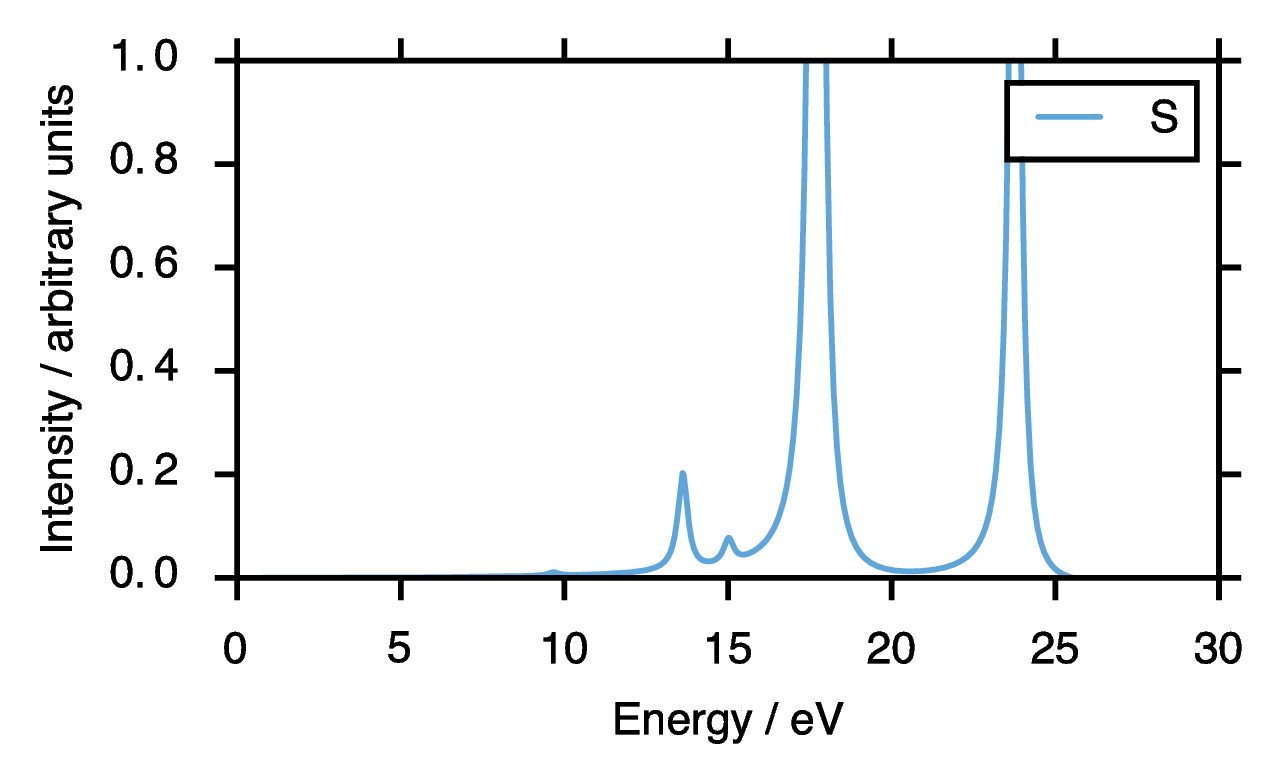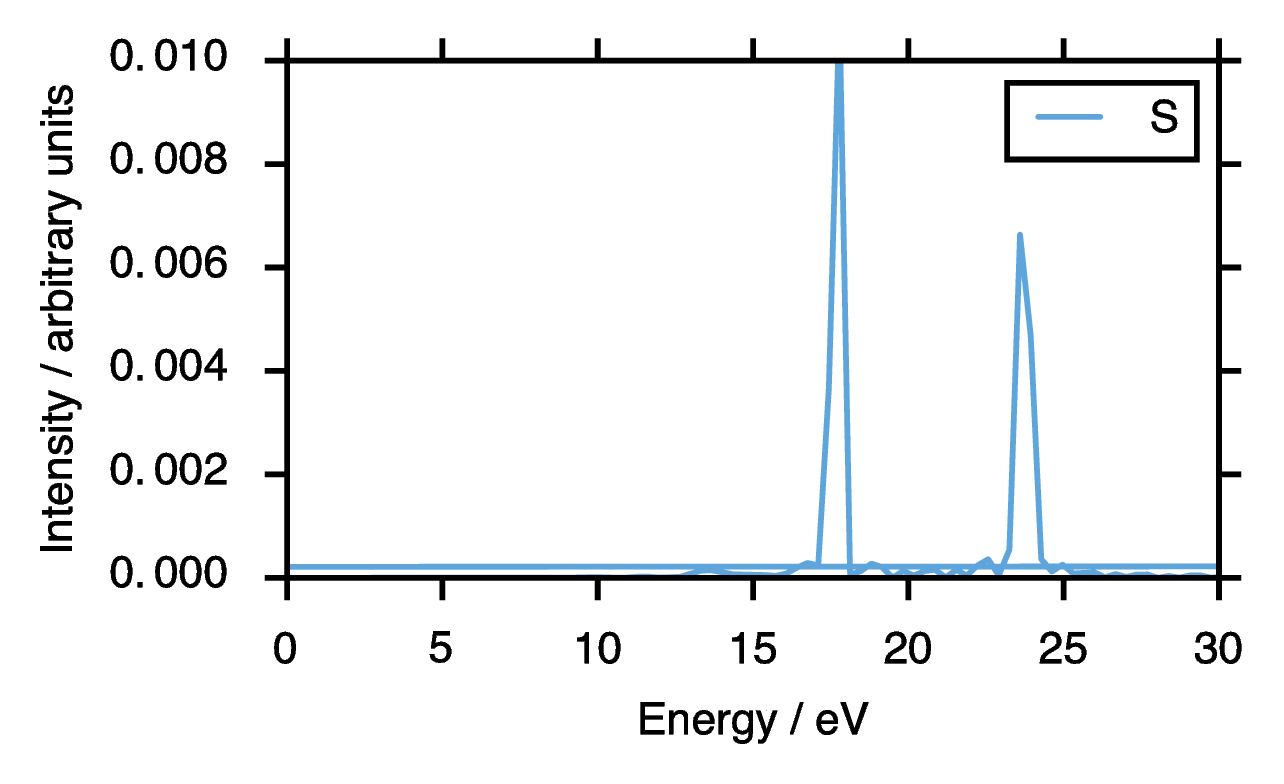This is a python script to generate the absorption spectrum from a real time time-dependent SCF calculation in the output of Chronus Quantum.
It also provides the options to try compressed sensing techniques on your time series. (Still experimental, so see end of this README).
You can run the script as-is on the provided output (water/Restricted Hartree-Fock/STO-3G), just:
$ python cq_realtime.pyThe files are hard-coded into the main part of the script. You can always import the function cqRealTime in your own python scripts like so:
from cq_realtime import cqRealTimedef cqRealTime(real_time_file,dipole_direction,kick_strength,damp_const):
'''
CQ_RealTime.py: a post-processing script for computing the absorption spectrum of
Real Time Time Dependent SCF jobs in Chronus Quantum
Computes the energy range, w (in eV) and dipole strength function S(w) for
a given real time TD-SCF run.
real_time_file ... type:string ; the RealTime_Dipole.csv file from a ChronusQ run
dipole_direction ... type:char ; which dipole moment contribution is computed (e.g. 'x','y', or 'z')
kick_strength ... type:float ; in a.u., what was the applied field strength (e.g. 0.0001 au)
damp_const ... type:float ; in a.u. of time, gives FWHM of 1/damp_const
cs ... type:boolean; if True, do compressed sensing instead of Fourier Transform
'''Returns w, and S, which are the frequencies and absorption cross sections.
Three input files are included for water in a STO-3G basis. If you have ChronusQ installed, you can run these files.
To get the absorption spectrum you need to give the system three independent "perturbations," so we give the system a delta-function electric field "kick" at the beginning (e.g. turn on the field for one time step) in three different directions (x,y,z).
Then we measure the time-evolving dipole moment of the system along the polarization of that field. A Fourier transform of this time evolution is proportional to the dipole strength function, and also related to the absorption cross section (which we measure in lab in a UV-Vis experiment).
The overall dipole strength function is determined by adding the "x dipole response to the x-delta kick" to the "y dipole response to the y-delta kick" to the "z dipole response to the z-delta kick".
This code is written in Python 2.7 and requires numpy, matplotlib, and SciPy. On Ubuntu you can just:
$ sudo apt-get install python-numpy python-scipy python-matplotlib Or on Fedora:
$ sudo yum install numpy scipy python-matplotlib For Mac OS X, if you use Macports:
$ sudo port install py27-numpy py27-scipy py27-matplotlib For comparison, if you do the FFT analysis of the real-time data on the water example provided, your peaks and relative intensities should match the output below:
Remember, f is the dimensionless oscillator strength, and gives the magnitude of your peak at the given energy. So you should see a large peak at 17.7 eV, since it has the largest f, but no peak at 11.3 eV, because its f is zero.
Excited State 1: Singlet-B1 9.6540 eV f=0.0021
Excited State 2: Singlet-A2 11.3014 eV f=0.0000
Excited State 3: Singlet-A1 13.6088 eV f=0.0548
Excited State 4: Singlet-B2 15.0044 eV f=0.0140
Excited State 5: Singlet-B2 17.6951 eV f=1.0986
Excited State 6: Singlet-A1 23.7684 eV f=0.6030
Excited State 7: Singlet-A1 34.9187 eV f=0.0219
Excited State 8: Singlet-B2 36.0245 eV f=0.0022
If you want, you can try using compressed sensing techniques to replace the Fourier transform.
In principle, this is a technique to exploit the sparsity in the Fourier transform to beat the Nyquist–Shannon sampling theorem.
It is more expensive, so the default is to prune your time series to the first 1000 samples.
Details of the theory can be found in:
Andrade, X., Sanders, J. N., & Aspuru-Guzik, A. (2012). Application of compressed sensing to the simulation of atomic systems. Proceedings of the National Academy of Sciences of the United States of America, 109(35), 13928–13933. http://doi.org/10.1073/pnas.1209890109
###Dependencies To use, you'll need to get the CVXPY package: http://www.cvxpy.org/
You can use pip:
$ pip install cvxpy
###Use
To use, open the cq_realtime.py file. Edit the option doCS at the bottom so that doCS = True. This will do the compressed sensing technique when you run cq_realtime. Feel free to play around with the defaults. The CS function is found in cs.py.
###Defaults The default is to do a Basis Pursuit Denoising (BPDN) problem with a noise value of 1e-7, and a frequency space augmentation of 5 times the size of your time series. Time series are pruned to first 1000 samples.
###Example
Here is an example of what you get when you do the CS technique on the first 1000 samples of the h2o_RealTime datasets. On my machine it took around 30s to compute. On older machines this default setting may take upwards of a few minutes.

